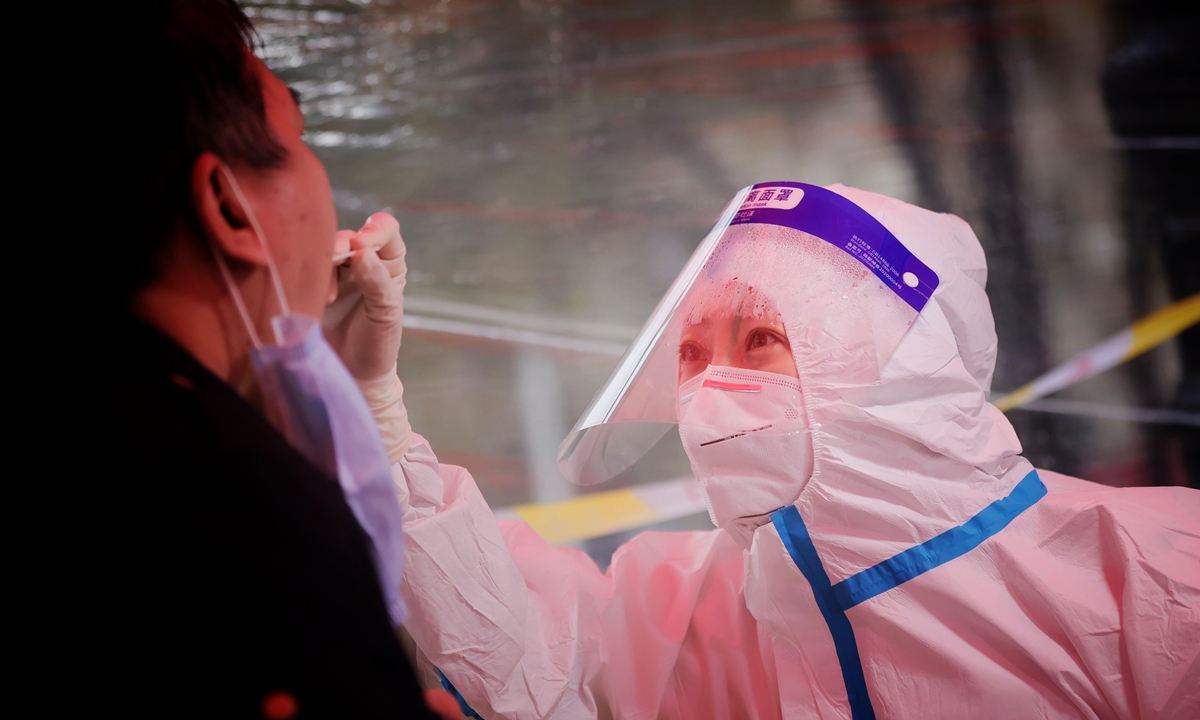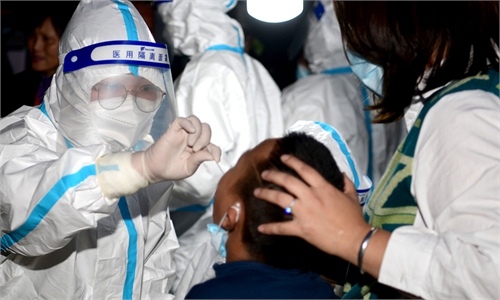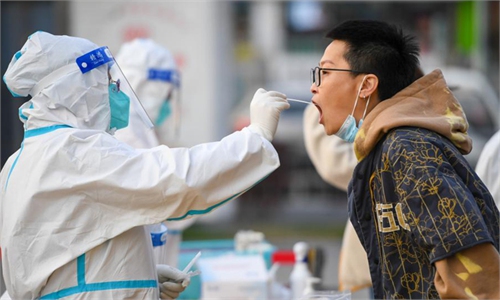Fresh epidemic resurgence occurs when outbreaks in 14 provinces yet to be over
Recent flare-ups likely to be effectively controlled within a month: experts

A community in Daoli district of Harbin, Northeast China's Heilongjiang Province, starts nucleic acid testing for all its residents on October 31, 2021 after Harbin reported one confirmed case and two positive cases on October 30. Photo: VCG
More regions including East China's Jiangxi Province and Northeast China's Heilongjiang Province are grappling with a fresh epidemic resurgence, even as the COVID-19 transmission chain related to Northwest China has yet to be cleared.
Calming the public, Chinese experts said that they expected the latest resurgence will be effectively controlled within a month under the country's zero-tolerance policy, which has proved to be effective and will be sustained in face of the dual threats posted by the Delta variant as well as cold weather.
The number of domestically transmitted cases in the Chinese mainland on Saturday was 48, with 19 from Heilongjiang, 10 from North China's Inner Mongolia, nine from Northwest China's Gansu, three in East China's Shandong and three in Northwest China's Ningxia.
Another two were reported in Southwest China's Yunnan, one in Beijing and one in East China's Jiangxi, according to data from the National Health Commission (NHC).
Just as the general epidemic related to Northwest China turned brighter in recent days, outbreaks in Heilongjiang and Jiangxi made national headlines.
At least two people working for a holiday resort in Jiangxi tested positive. As a means to curb the huge traffic flows, Yanshan county - where the resort is located - even said on Saturday that all traffic lights will be turned to red. The mandate to switch all traffic lights to red was quickly withdrawn on Sunday morning after it made national headlines. It is unknown if the local outbreak has any relation to with the recent ones in Gansu or Inner Mongolia.
A region in the county was labeled as medium-risk on Sunday, raising the total medium-risk regions in China to 26 and total high-risk regions to two.
The outbreak in the China-Russia border city Heihe, Heilongjiang, which is an isolated viral chain that was caused by an imported case and is unrelated to cases in Inner Mongolia or Gansu, rapidly escalated since October 27.
New cases have continued to be detected by mass testing, suggesting that viral spread has caused community transmission and thus poses the risk of further spreads or spillovers, according to the NHC.
Of 19 new local cases on Saturday, 18 were reported in Heihe and one in Harbin. Affected by the local outbreak, classes will be suspended in the capital city Harbin, and all primary and middle schools will have closed-loop management.
Qiqihar, another city in Heilongjiang, launched mass nucleic acid tests in counties neighboring Heihe.
To curb infection spillovers, the health codes of all residents in Heihe have been turned to yellow. The health code is an important pass to travel around in China.
Mi Feng, an NHC spokesperson, on Saturday warned that COVID-19 outbreaks have swept 14 provincial-level regions across China in the past two weeks. The current epidemic is still in a rapidly developing phase and remains complicated.
Voices seeking to discredit the zero-tolerance policy are rising, as they said that such a wide scale resurgence is testing the country's limits, and some even wantonly highlighted the negative impact caused by the strict anti-epidemic measures.
Such a policy prevents the virus from spreading across the vast country at the price of limiting the normal lives of a small proportion of key groups. With the policy, China has wiped out domestic infections and guarded the country against going through waves of imported COVID-19 resurgence. It has helped gradually stabilize the epidemic situation relating to Northwest China's regions, through tracking down close contacts and cutting off transmission, Wang Guangfa, a respiratory expert at Peking University First Hospital, told the Global Times.
"That is a stark contrast to the situations in many Western countries where epidemics have swept across the whole country with multiple transmissions. They have to take a laissez-faire approach as they do not have the capacity to operate such a policy, which requires the united resources of all. Only China can do this, which has proved to be a success," Wang said.
China, still a developing country, has unbalanced medical resources across the country, so the situation of having thousands of new cases like that in the West is not something the country could bear, not to say the double risks brought by the highly contagious Delta variant and the cold weather in winter, Wang said.
As more experience has been gained, China's zero-tolerance policy has been adjusted to minimize the adverse impact brought by the strategy, with coping measures affecting much smaller areas and emergency measures rolling out faster, Wang said.
The risk of spread and spillovers in the China-Mongolia border city Ejin Banner, Inner Mongolia has been effectively controlled as most new cases detected in recent days were identified at quarantine points. Previous anti-epidemic measures have proved to be effective and viral transmission in communities has been basically controlled.
Although small clusters of sporadic cases have occurred in some areas of China, China's top respiratory expert Zhong Nanshan said that he believes it will be effectively controlled within a month.
The Global Prediction System of COVID-19 Pandemic developed by researchers from the Collaborative Innovation Center for Western Ecological Safety of Lanzhou University indicates that the nationwide resurgence is likely to be controlled before November 9. The total confirmed infections are likely to stay between 415-771.
As for when is the best time for China to open its doors, Wang believed that could only happen if a large percentage of people get vaccinated, bringing herd immunity in China. But China could consider opening its doors to major economies, as well as to neighboring countries if they can control outbreaks at a very low level, Wang predicted.
As of Saturday, China had administered more than 2.26 billion doses of COVID-19 vaccines, and the number of people who had completed the full course of vaccination exceeded 1.07 billion.
As the vaccine roll-out continues, China will encourage children aged 3 to 11 years old to get vaccinated.
Zhong said it is expected that about 80 percent of Chinese people will complete vaccination by the end of 2021.


